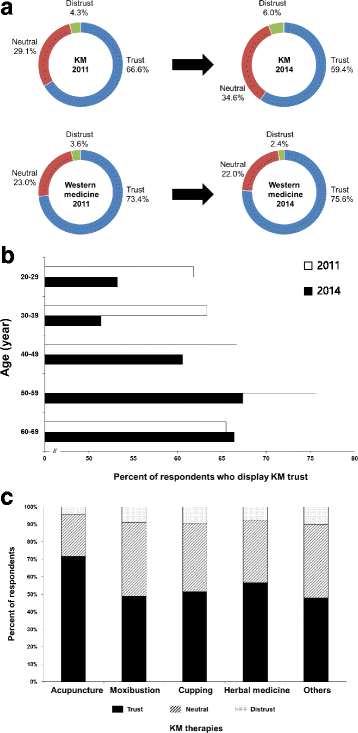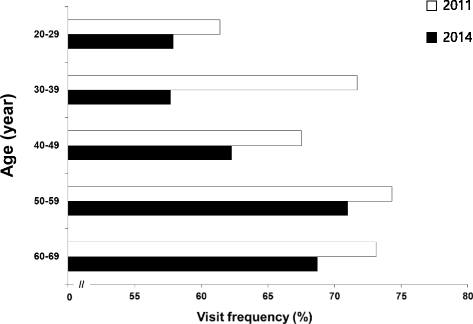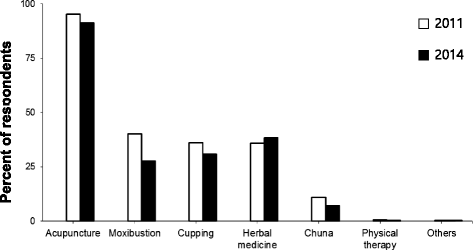Changes in trust and the use of Korean medicine in South Korea: a comparison of surveys in 2011 and 2014
- PMID: 28915876
- PMCID: PMC5603087
- DOI: 10.1186/s12906-017-1969-8
Changes in trust and the use of Korean medicine in South Korea: a comparison of surveys in 2011 and 2014
Abstract
Background: Korean medicine (KM) has been widely used in Korea. This study aimed to assess the general perceptions of KM, to investigate the patterns of its usage in 2014, and to compare the results with those of an earlier survey from 2011.
Methods: A cross-sectional study was conducted with 1000 Korean people. The questionnaire included items regarding trust in KM, reasons for distrust of KM, and visit frequency to KM clinics. This study used methods consistent with those of a 2011 survey to examine changes in attitudes over 3 years.
Results: Despite high rates of trust in KM, the visit frequency decreased from 69.3% in 2011 to 63.2% in 2014. Usage among young adults (in their 20s and 30s) was significantly reduced compared to all other age groups. The KM modality most commonly used by participants was acupuncture, whereas the use of moxibustion and cupping therapies has decreased since 2011. Men and women were most likely to distrust KM due to a "lack of scientific evidence" (59.3%) and "suspicion of KM safety" (47.4%), respectively.
Conclusions: The findings suggested that KM use and trust in KM were slightly lower in 2014 than in 2011. The decreases were most notable among individuals in their 30s and in the use of moxibustion in KM therapy. This study aimed to produce practical insights by reviewing patterns of KM use and perceptions over time. Additional surveys must be considered to produce a more in-depth analysis.
Keywords: Korean medicine; Perception; Periodic survey; Prevalence; South Korea.
Conflict of interest statement
Ethics approval and consent to participate
Ethical approval was not needed for this study.
Consent for publication
All authors consent to this manuscript’s publication.
Competing interests
The authors declare that they have no competing interests.
Publisher’s Note
Springer Nature remains neutral with regard to jurisdictional claims in published maps and institutional affiliations.
Figures



Similar articles
-
Changes in attitudes toward and patterns in traditional Korean medicine among the general population in South Korea: a comparison between 2008 and 2011.BMC Complement Altern Med. 2014 Nov 7;14:436. doi: 10.1186/1472-6882-14-436. BMC Complement Altern Med. 2014. PMID: 25380563 Free PMC article.
-
An assessment of the use of complementary and alternative medicine by Korean people using an adapted version of the standardized international questionnaire (I-CAM-QK): a cross-sectional study of an internet survey.BMC Complement Altern Med. 2018 Aug 13;18(1):238. doi: 10.1186/s12906-018-2294-6. BMC Complement Altern Med. 2018. PMID: 30103722 Free PMC article.
-
Usage patterns and adverse experiences in traditional Korean medicine: results of a survey in South Korea.BMC Complement Altern Med. 2013 Dec 1;13:340. doi: 10.1186/1472-6882-13-340. BMC Complement Altern Med. 2013. PMID: 24289266 Free PMC article.
-
[Development of studies on influence of patients' expectations on therapeutic effects of acupuncture and moxibustion interventions].Zhen Ci Yan Jiu. 2014 Jun;39(3):256-8. Zhen Ci Yan Jiu. 2014. PMID: 25069206 Review. Chinese.
-
A close look at an integrative treatment package for Bell's palsy in Korea.Complement Ther Clin Pract. 2017 Feb;26:76-83. doi: 10.1016/j.ctcp.2016.12.003. Epub 2016 Dec 24. Complement Ther Clin Pract. 2017. PMID: 28107855 Review.
Cited by
-
Cost-Effectiveness of Chuna Manual Therapy and Usual Care, Compared with Usual Care Only for People with Neck Pain following Traffic Accidents: A Multicenter Randomized Controlled Trial.Int J Environ Res Public Health. 2021 Sep 23;18(19):9994. doi: 10.3390/ijerph18199994. Int J Environ Res Public Health. 2021. PMID: 34639295 Free PMC article. Clinical Trial.
-
Factors Affecting Korean Medicine Health Care Use for Functional Dyspepsia: Analysis of the Korea Health Panel Survey 2017.Healthcare (Basel). 2022 Jun 25;10(7):1192. doi: 10.3390/healthcare10071192. Healthcare (Basel). 2022. PMID: 35885719 Free PMC article.
-
Association between subjective health status and frequency of visits to acupuncture clinic: A cross-sectional study.PLoS One. 2022 Nov 17;17(11):e0277686. doi: 10.1371/journal.pone.0277686. eCollection 2022. PLoS One. 2022. PMID: 36395152 Free PMC article.
-
Use of Herbal Decoction and Pharmacopuncture in Individuals with Chronic Disease: findings from a nationally representative panel.J Pharmacopuncture. 2024 Jun 30;27(2):110-122. doi: 10.3831/KPI.2024.27.2.110. J Pharmacopuncture. 2024. PMID: 38948306 Free PMC article.
-
National Health Insurance Data Analysis for the Second-Wave Development of Korean Medicine Clinical Practice Guidelines in South Korea.J Pharmacopuncture. 2023 Jun 30;26(2):198-209. doi: 10.3831/KPI.2023.26.2.198. J Pharmacopuncture. 2023. PMID: 37405112 Free PMC article.
References
-
- Woo JM, Cho SH. Traditional Korean medicine practitioners’ attitudes toward evidence based medicine: a qualitative study. Eur J Integr Med. 2012;4:e448–ee54. doi: 10.1016/j.eujim.2012.09.004. - DOI
Publication types
MeSH terms
LinkOut - more resources
Full Text Sources
Other Literature Sources
Medical

